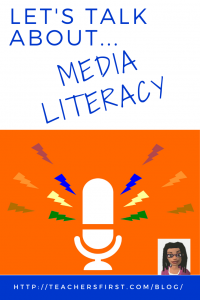
As we begin to resume our K-12 charge – educating the children of our nation – we will need to contend with the diverse issues that our students have been hearing about. From the Black Lives Matter movement to the upcoming presidential election and everything in between, students have been inundated with media. There is always the temptation to present information to students that aligns with one’s own worldview; educators, however, must move beyond that initial urge. We must give our students the tools to dissect the messages presented to them and craft appropriate responses. Now, more than ever, it’s imperative that we teach our students to be media literate.
As students begin to research the issues before them, they need to be able to critically examine sources. Students need to be able to craft creative, responsible contributions to the discourse on the topics they are passionate about as they find their voices and are moved to take action on both local and global levels. School is a great place to practice these skills, and as educators, we can give students a safe space to develop and hone these abilities.
Wondering where to start? Glad you asked! Take a look at this curated collection of media literacy resources on TeachersFirst®️, which includes our favorite resources for media literacy instruction. There also are three great opportunities coming up next week for students to practice finding and vetting resources and responding to their research:
104 Years of the National Park Service
The National Park Service will celebrate its 104th birthday on August 25. Challenge students to learn about the National Park Service, the Great American Outdoors Act, and President Roosevelt. Use Diigo (reviewed here) to save resources, organize them, and take notes. Ask students to show what they have learned using Microsoft’s free digital storytelling tool, Sway (reviewed here). As a web-based tool, Sway will allow students to work collaboratively and on any device. Not familiar with Sway? Check out our archived OK2Ask®️ workshop on Sway Cool Student Projects.
Women’s Equality Day
Women’s Equality Day is August 26. This year it commemorates the 100th anniversary of the passage of the 19th amendment to the constitution, which gave women the right to vote. Have students research the 19th amendment, the women who led the movement, and Sojourner Truth’s famous speech. Try a project-based assessment for this activity. Allow students to curate a list of resources to teach someone about the 19th amendment. You’ll discover what they’ve learned in their research when you see what the student has chosen to include. Have students use elink (reviewed here) to publish the list as a web page.
Anniversary of the March on Washington
The 57th anniversary of the March on Washington for Jobs and Freedom, where Dr. Martin Luther King, Jr gave his famous “I Have a Dream” speech on August 28, is another opportunity for students to practice media literacy. Researching topics such as the civil rights movement can take many forms. Graphic novels such as March: Book One can be helpful for students that are hesitant to read. These students may be more comfortable creating an interactive Google drawing when asked to report out on their research work.
Remember, when students do research, the goal isn’t to have them create PowerPoint presentations with bells and whistles. We want students to evaluate resources for validity as they research a topic or issue, then create an authentic product as a response. Be sure to allow a range of presentation options and tools so that students have a variety of ways to practice as they find their voice.
What activities do you use to teach media literacy? Let us know in the comments below.

